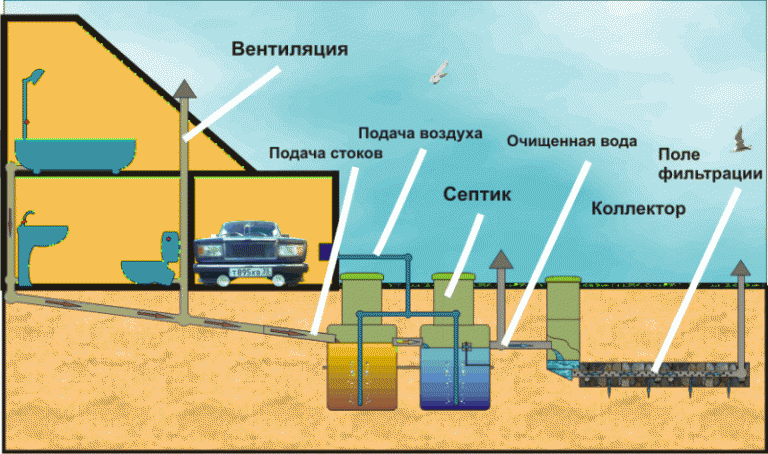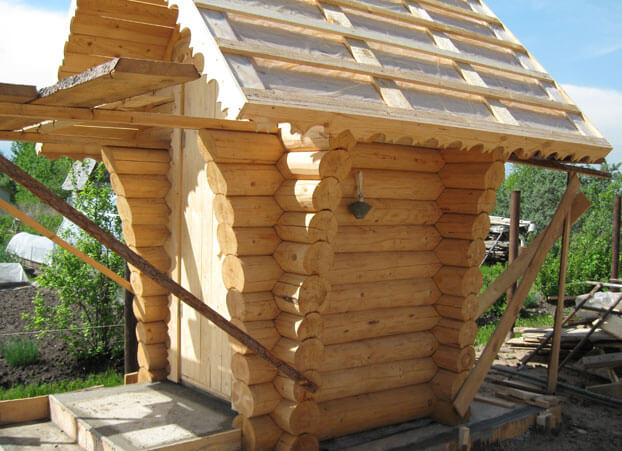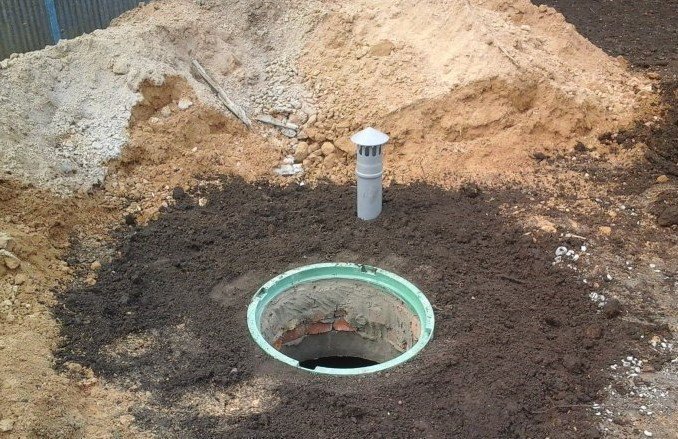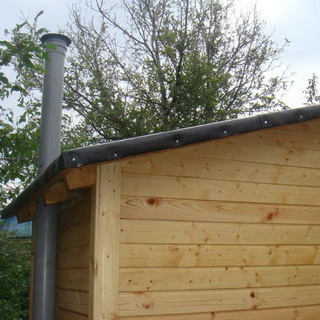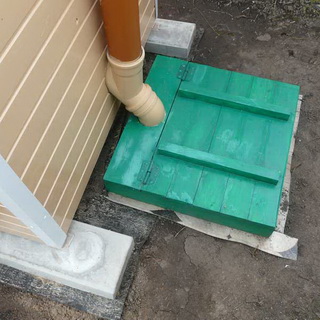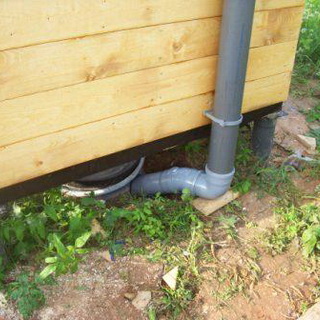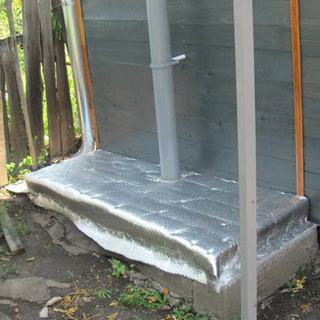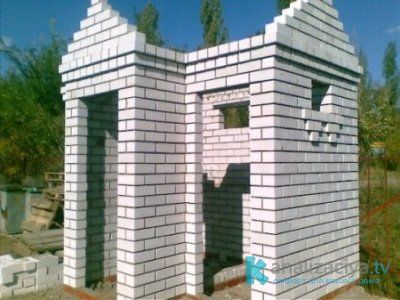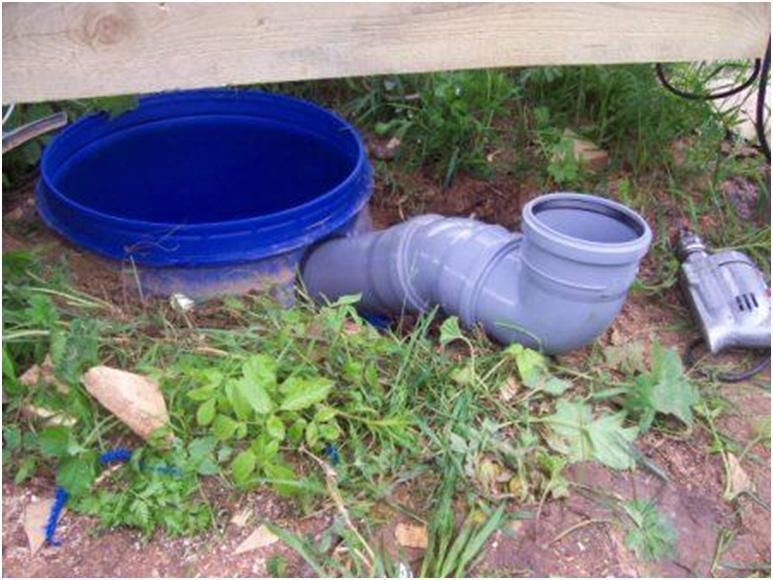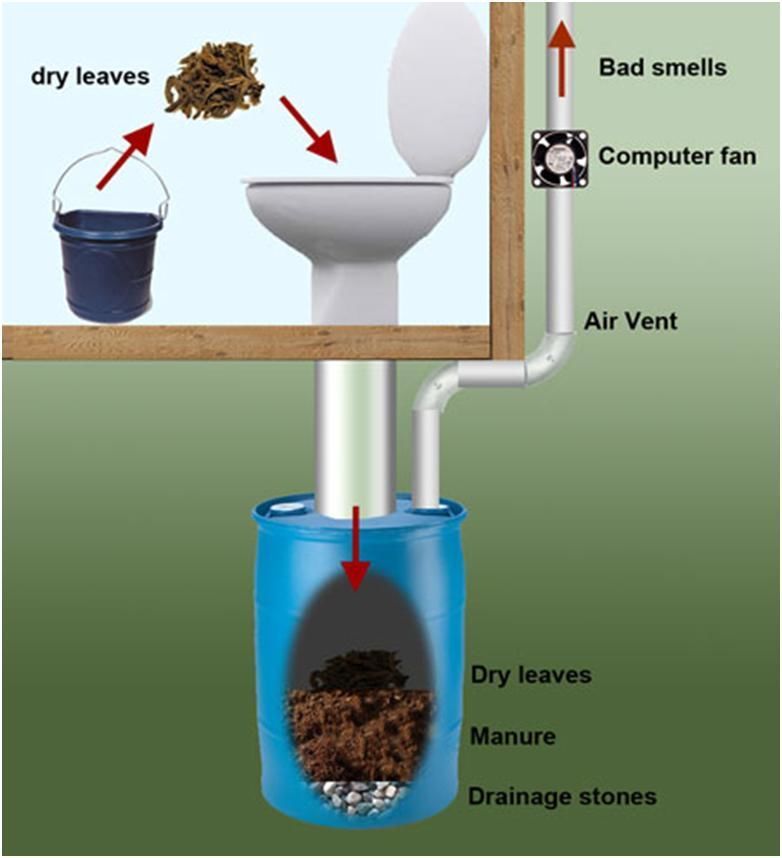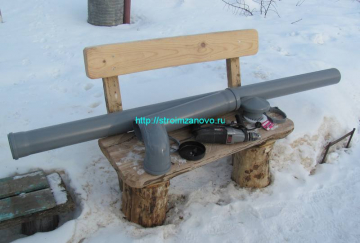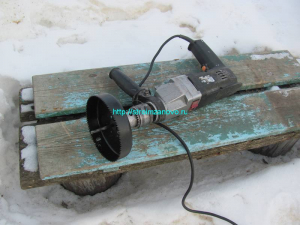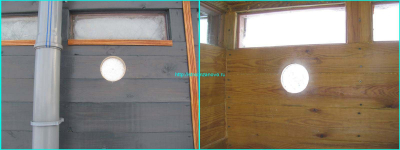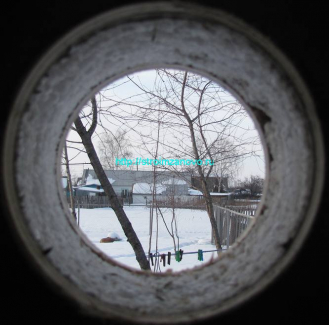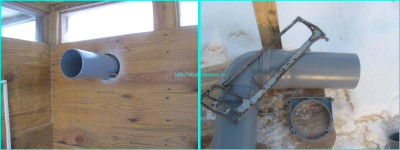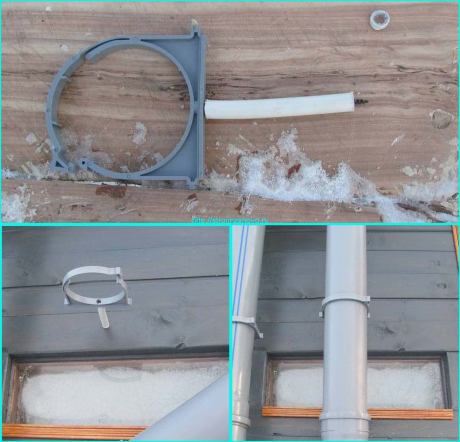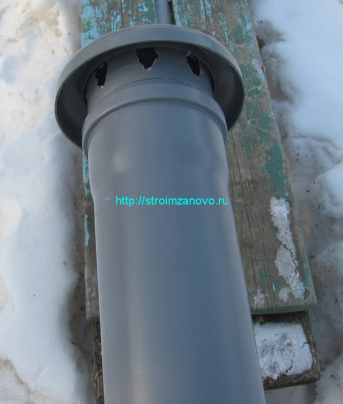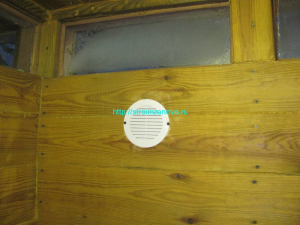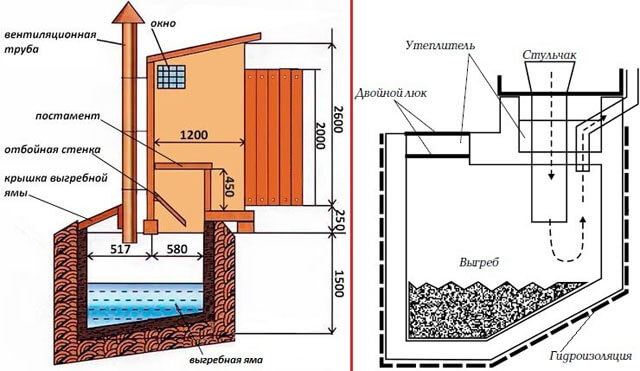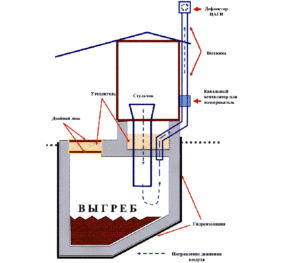Waste tank ventilation
To solve this problem, a hole for an air exchange pipe is provided in the design of the tank for collecting and filtering waste. Such a hole is located on the roof. The diameter must not be less than 100 mm. The material used is standard sewer plastic pipes.
Rules for installing a septic tank ventilation pipe:
- A smaller diameter pipe (50 mm) is inserted into a 100 mm pipe.
- The structure should rise above the ground by at least 50 cm. Melt and rainwater should not fall into the pit or septic tank. It is better to "pull out" the pipe to a height of at least 150-200 cm (above human height) so that the smells coming out do not bother people.
- The end of the hood is equipped with a deflector, which improves the circulation of air masses and protects the pipe from dirt, snow, leaves.
- The pipe can be insulated so that it does not clog with ice in the winter.
If the septic tank is seriously deepened into the ground, a special viewing hole is equipped for maintenance work. To facilitate inspection and operation, a ventilation pipe is mounted in this inspection hole.
In many private houses and cottages (especially old ones), a cesspool is arranged directly under the toilet. The toilet may look like a stand-alone cubicle or be part of a common building. It doesn't matter for ventilation. In such a situation, the ventilation pipe is mounted in the roof of the cesspool and brought out next to the toilet to a level of at least 200-250 cm. The pipe is located vertically.
When planning a private house or cottage, you should avoid building a toilet over a cesspool. It is better to equip the drain tank separately and bring sewer communications from the toilet and other objects to it using pipes.
The location of the cesspool at a distance allows you to mount additional ventilation pipes using tees in a convenient place in the fresh air. But it is worth remembering that the installation of such additional structures is acceptable only if there is a drain in the toilet.
If the house has a basement or cellar, the sewer ventilation pipe should not be led into these rooms.
For obvious reasons, the unpleasant odor will be concentrated in the basement. Basement ventilation should also not be connected to the air supply to the sewer or cesspool.
It is not necessary to bring the ventilation pipe into the cellar of a private house
What is more profitable, build or buy
What is more profitable to buy a ready-made house for an outdoor restroom or build it yourself? This choice is entirely up to the landlord.
To build a toilet in the form of a hut from a wooden base and sheathe it with clapboard, you will need:
The approximate number of building materials that are needed for the construction of such a bathroom:
- edged boards - one 6 meters, and the second - 4 meters;
- floor board - 4 pieces 6 meters long;
- three-meter lining - 2-4 packs;
- roofing material - 1.5 meters;
- glassine - not less than 4 meters;
- sand - about 2 buckets;
- galvanized nails - 2 kilograms;
- nails for slate - 20 pieces;
- nails without hats - 2 kilograms;
- self-tapping screws;
- 8-wave slate - 2 sheets;
- door with fittings;
- galvanized iron for the ridge - 1 sheet;
- antifungal compound.
general information
Before dealing with ventilation, you need to clarify how an autonomous sewage system works. Autonomous sewerage - a system of pipelines for removing waste from a building, ending in a cesspool. Cesspools can be of several types:
- Pit with an earthen bottom, absorbing type.
- Pit sealed type.
- Septic.
The simplest and most common version of a cesspool is a construction with an earthen bottom.
The earth provides natural absorption and purification of water. Such "economical" sewage is harmful to the environment, as it does not provide the proper level of cleaning from fecal and other effluents from the house.
The sealed pit is equipped with concrete rings and slabs. The joints of the cesspool of concrete rings are sealed. Such sewerage is safe for the environment, but requires frequent cleaning and pumping out waste.
A septic tank is the most efficient system. It can be homemade or industrial production. A home-made septic tank provides reliable wastewater treatment and removal of the purified liquid into the soil due to the arrangement of the bottom with filter materials from several layers (gravel, broken brick, stones, slag concrete). The walls of the septic tank can be made of concrete rings, bricks or other improvised materials.
Any type of cesspool requires the arrangement of a ventilation system. Industrial septic tanks can be equipped with an additional biological treatment system and an integrated ventilation system that will effectively eliminate all odors and gases. With the independent construction of a cesspool or septic tank, ventilation is designed taking into account the characteristics of the wastewater tank, its characteristics and location.
The tasks that ventilation solves in the autonomous sewerage of a private house:
- Removal of bad odor.
- Removal of organic decomposition products (methane and other compounds), large volumes of which can lead to poisoning, fire and even explosion.
- Maintaining optimal pressure in the pipeline.
When waste is drained, a space of rarefied air or vacuum is formed in the pipe. After passing through the waste, the rarefied space, according to the natural laws of physics, is filled with air. If there is ventilation, filling occurs due to the intake of fresh air through special pipelines.
If there is no special design for air exchange, the freed up space will be filled from the holes in the house (sink, bathtub), and this will lead to disruption of the sewer system.
The ventilation system can be of two types:
- natural;
- forced.
The ventilation system in the sewer pit can be natural and forced
Temperature affects the pressure, the difference of which ensures the movement of air masses. In a forced system, air exchange is ensured by the equipment of additional ventilating equipment that pumps air.
Forced ventilation in a private house consists in connecting an exhaust fan to the vent pipe, which will remove an unpleasant odor from the room outside the building. The fan is neatly mounted in the exhaust duct and connected to the power supply.
Do-it-yourself ventilation in the country toilet
Scheme of ventilation of a country toilet
Most country toilets are built like a cesspool, which has a serious drawback - these are fetid gases that appear as a result of fermentation of feces. It is impossible to hermetically close the pit, so ventilation is necessary in the country toilet.
You can do all the work on installing the ventilation of the toilet in the country with your own hands. The ventilation of a country toilet is usually a single pipe leading from a pit along the back wall of the toilet. It ends 75 cm above the roof level. Pipes made of PVC or asbestos cement with a diameter of 10 cm are used. Metal brackets are convenient as fasteners.
A special hole for ventilation is provided in the cesspool, where the pipe is installed even before concreting. However, sometimes such a ventilation scheme for a country toilet is not always effective and odors penetrate into the cabin. You can assemble with your own hands the ventilation of the cabin of the country toilet. To do this, you need to purchase:
- two pieces of PVC pipe 0.5 m and 2 m with a diameter of 11 cm;
- 90 degree corner connection;
- umbrella or deflector;
- decorative lattice;
- fixture.
The exhaust hole for ventilation of the toilet in the country is drilled in the wall, as close as possible to the roof. The diameter of the hole must match the diameter of the pipe. The pipes are connected with a corner, a short piece is inserted into the hole. An extra piece of pipe from the inside of the room is sawn off. A deflector or umbrella is put on the upper cut of a long pipe, using a level, it is necessary to check the vertical position of the pipe, after which it is attached to the wall with long screws and clamps. A ventilation grill is installed at the outlet of the pipe inside the toilet. To prevent blowing into the slots, they are filled with silicone or polyurethane foam.
To ensure the flow of clean air into the booth, a small hole is made on the opposite wall (from the one where the exhaust pipe was inserted). It should be no higher than 0.2 m from the floor level and covered with decorative ventilation grilles.
The ventilation of an outdoor toilet will work according to this principle: fresh cool air enters the cubicle, rises up along with unpleasant odors and goes outside. But before you make ventilation of the toilet cubicle in the country, you need to take care of the removal of gases from the cesspool. Otherwise, do-it-yourself ventilation of the country toilet will not be effective enough to deal with the stench.
http://strojdvor.ru
Ventilation of the cesspool of a street toilet in the country with a photo
One of the main disadvantages of a cesspool is the release of gases. The decomposition of faeces is a process of acidic fermentation, as a result of which organic acids are formed and fetid gases, including hydrogen sulfide, are released.
It is almost impossible to make the cesspool completely airtight. Gases must be removed from the cesspool, otherwise they can penetrate through various cracks into nearby living quarters. The hygiene of the toilet is ensured by a mosquito net installed on the window of the toilet, and a ventilation pipe brought to the level of its roof or 70-80 cm above it.
Exhaust ventilation in the toilet in the country from asbestos-cement or plastic pipes with a diameter of 100 mm should be fixed to the rear wall of the toilet cubicle using metal brackets.
It is recommended to install a spigot in the vent before concreting. It should be noted that the hood is not always enough to ensure high-quality and efficient ventilation in an outdoor toilet in the country, sometimes odors cannot be completely eliminated even with the help of a special ventilation pipe.
A cesspool cannot be arranged if there is an intention to use feces as fertilizer, therefore, when building new buildings, it makes no sense to arrange such toilets.
To eliminate odors when installing ventilation in a country toilet with your own hands, it is necessary to strengthen draft in the pipe. The easiest way to do this is to use the energy of the sun or wind to increase traction.
The back wall should be covered with a sheet of metal painted black. In this case, the sun will heat the duct, and hot air, which is much lighter than cold air, will rise up.
The photo of the ventilation in the toilet in the country house shows how the installation is done:
To use the force of the wind for the same purposes, it is necessary to place a deflector from a conical nozzle and a cap protecting the booth and cesspool from precipitation on the head of the pipe.
The nozzle can be made from a small galvanized bucket with a broken bottom. It must be fixed to the pipe with a clamp. The cap in the form of a cone should be tightly fixed to the nozzle using three metal "legs". The deflector, with which the wind will increase the upward flow of air in the ventilation pipe, can also be made of galvanized iron sheet.
(Visited 1 095 times, 1 visits today)
Device, scheme, principle of operation
An effective sewer ventilation system in a private house consists of two key blocks:
- Ventilation duct from a cesspool or septic tank.
- Fan pipe in the house.
The principle of operation of ventilation with a cesspool:
- the pipe above the cesspool works as a supply system, air is drawn into the sewer through it;
- through the fan pipe of the house, an unpleasant odor is discharged into the air space above the roof;
- when draining waste, excess air masses with an unpleasant odor are discharged through a pipe above the pit;
- the vacuum is filled by a vent pipe.
For the operation of such an autonomous system, it is important that the cesspool does not overflow and the vent pipe is not blocked by drains. Do not allow clogging of the channel above the septic tank and the fan pipe
For the purpose of prevention, it is worth equipping revision compartments and inspection pits in the system. They will help to eliminate the blockage, carry out repairs and restore ventilation if necessary.
Many people associate an outdoor toilet in the country with an unpleasant smell, dirt and danger. But modern summer residents strive to make the most comfortable and safe place out of such a toilet.
The design is a small cabin, wooden or brick, inside there is a toilet or a seat. Under the cabin is a cesspool, it is she, or rather, the accumulation of waste in it, that causes an unpleasant smell. In the process of decomposition, human waste emits a foul-smelling gas - methane, which, moreover, is also dangerous to health - when visiting the toilet, a person can lose consciousness.
Methane vapors penetrate the wood and destroy it, as a result, wooden floors deteriorate and there is a risk of collapse of the structure. Hence the conclusion: it is necessary to prevent the accumulation of gases and ensure their free exit. For this, ventilation is needed in the outdoor toilet.
Where is the best place to build a pit latrine?
As a rule, any place is not suitable for the construction of a country toilet. It must be placed following certain norms and requirements, since there is always a risk of groundwater contamination. When constructing a structure, it is necessary to take into account not only the location of your source of water consumption, but also the neighboring one.
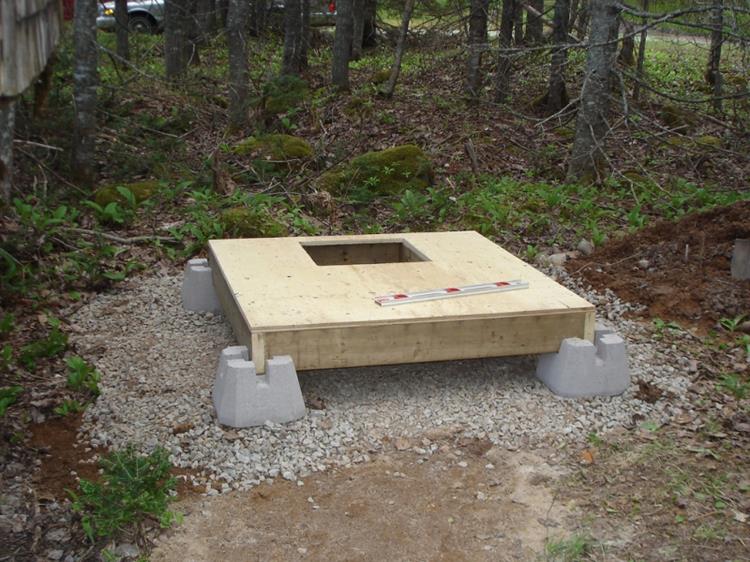
In the construction of a toilet pit in the country, depth and width are of great importance, while the most important thing is to comply with the following requirements:
- the distance of the toilet from the source of water, whether it be a river, a well or a well, must be at least 25 meters. In the case of an uneven summer cottage relief, namely the presence of drops and slopes, a cesspool should be made in a place that is below another level. As a result of this solution, the risk of dirty sewage getting into drinking water is significantly reduced;
- the toilet should be located at a distance of 12 meters from the house or other structure;
- if there is a bathhouse or an outdoor shower on the territory, then the distance to the object must be at least 8 meters;
- distance to sheds with animals - 4 meters;
- the toilet is located at a distance of 4 meters from the trees, and 1 meter from the bushes;
- the fence should be at a distance of 1 meter;
- when choosing a place for a toilet, you need to take into account the direction of the air, in the worst case, unpleasant odors will spread throughout your summer cottage;
- the front door should not be directed to neighboring windows;
- if groundwater is located at a depth of 2.5 meters, then you can build a toilet of various types. If this figure is higher, then you can not make a cesspool. In such situations, an excellent option would be to install a backlash closet, dry closet or powder closet. Such structures are harmless to the environment, since the waste does not come into contact with groundwater.
When choosing a place to build a toilet in a country house, you need to take into account not only the placement of your objects on the territory, but also those of your neighbors.It should be noted that the above norms apply only to those latrines for which it is planned to make cesspools.
It is also important to correctly determine the direction of the wind.
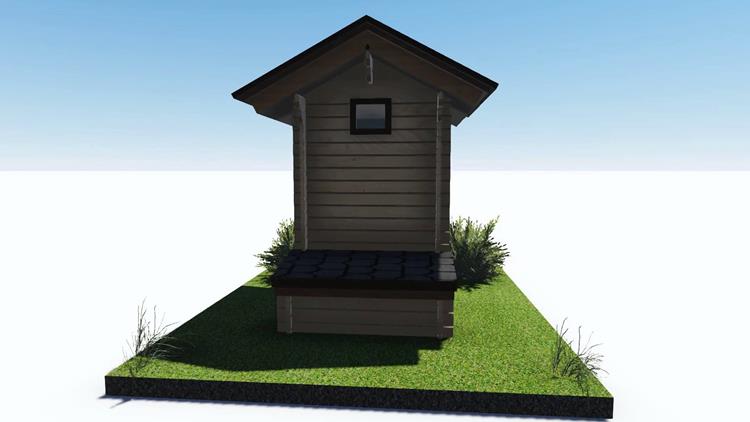
What are cesspools?
If a specific suburban area is not connected to the central sewerage system, then it is imperative to install a local sewerage system. There are two main types:
- a system with the accumulation of effluents;
- storage system with the possibility of bio-treatment of wastewater.
In addition, local sewerage can be non-volatile or volatile. In the first case, the flow of liquid will occur naturally, and in the second - with the help of a pump.
The simplest storage systems are presented in the form of sealed tanks that can be bought without any problems. If a decision is made to independently build, then a simple pit is made with a special drainage bottom.
Simple cesspools
Such a structure is a reservoir with an earthen bottom, through which there is a natural filtration of effluents. This type of structure is considered convenient and simple for a summer cottage, while there is no need to frequently pump out waste. Despite some advantages, the liquid is absorbed into the ground rather slowly. If there is a large volume of drains, then the pit is not the best option. In accordance with sanitary standards, the maximum volume of waste for such pits is 1 m3. In addition, it should be said that such pits can be dangerous to the environment. As a rule, dirty water, getting into the ground, is cleaned with the help of bacteria that live in the ground, and if the volume of effluents is exceeded, they will not be able to fully cope with their functions. Thus, there is a risk of untreated effluent entering the ground. If they mix with groundwater, well water can become contaminated.
Recommended reading: How to make a cesspool with your own hands without the need for pumping
To prevent the risk of contamination of drinking water, when installing a pit latrine, it is imperative to take into account all sanitary and building codes for this type of structure. The distance from the drinking well to the pit should be at least 20 meters in the case of clay soil, 30 meters for loam and 50 meters for sandy soils. Soil characteristics also affect the rate of runoff absorption. For example, in the case of highly clay soil, frequent pumping of the pit may be required.
Tips from experts
- To give the country toilet stability, it is necessary to securely fix the bottom of the structure.
- The outdoor toilet should be located about 20 centimeters above the ground.
- Sheathing should not be done over the pit, before that you need to mount the floor and equip the seat.
- Then a frame is built to the side and installed on a prepared base, which will require the help of two people.
- In the process, you need to control the vertical and horizontal with the help of a level.
- The door block is made to open outwards.
- You need to remember about the light window.
- When the walls are not sheathed with vinyl clapboard, they must be painted with paint.
- The wooden canvas is treated with an antiseptic.
Based on the information provided in the article, it is clear that the device of a country toilet with a cesspool is not a difficult task. Home craftsmen will need to have the skills to perform construction work. Preliminarily, it is desirable to draw a detailed drawing (sketch) of the structure. You should also determine and purchase the required amount of building materials in advance so that you do not have to go to a specialized store once again.
Types of ventilation systems and their principle of operation
The organization of air exchange depends on the chosen type of ventilation system, each of which has its own characteristics, advantages and disadvantages. In this regard, ventilation in the toilet in the country can be natural or forced.
Natural air circulation is carried out as a result of natural processes. Such ventilation is characterized by:
- minimal financial costs;
- ease of installation;
- complete dependence on weather factors (wind, difference between internal and external pressure).

Forced ventilation is a method of artificial ventilation, which includes the use of special electrical equipment (fans, air conditioners, etc.).
- fast reverse of air masses;
- does not depend on external factors;
- relatively high cost;
- the need for maintenance.
The intensity of ventilation is affected by the direction and strength of the wind.
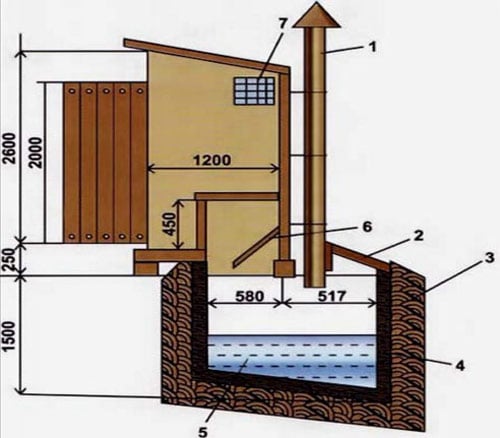
Materials for external construction
In the case of the second part of the country toilet, an external building, the choice is already larger, because there are no large loads from the environment, only humidity and precipitation. To protect against this, it will be enough to make the roof of such a building from more durable materials, and then the desires of the owner of the house are no longer limited to anything. The most popular options are:
It is wooden toilets that are classic. Today, you can purchase such buildings even ready-made, in special workshops or hardware stores.
• Plastic.
There are two options available here. These can be either ordinary bio-toilets, which you can buy ready-made in hardware stores, or buildings made of plastic panels. They have become very popular lately.
If after the construction of the house, there is a little brick left, the construction of a country toilet will be an excellent option for its use. Such a building will not only last a very long time, but will even decorate your site. This list goes on and on. Craftsmen can build any part of a country toilet literally from improvised materials, but regardless of your choice, you will always have to follow certain recommendations for building a house.
How to make ventilation
Before starting work, prepare the necessary tools:
- bayonet shovel;
- drill - if the walls of the booth are wooden;
- perforator - if brick walls;
- hacksaw for metal;
- roulette;
- level;
- self-tapping screws.
DIY cesspool ventilation system
With the help of a bayonet shovel, a hole is dug above the pit, the diameter of which should be slightly larger than the size of the pipe. Such a hole should be made near the rear wall of the cabin so that the pipe can be conveniently fixed with clamps. Lower the pipe into the pit to a depth that is less than the maximum fill mark. That is, so that waste does not get into the ventilation shaft.
With the help of fasteners and clamps, the pipe is fixed on the wall of the booth. The bottom is dug in with earth. A deflector or umbrella is put on top.
The advantages of the deflector is that this device is able to increase traction up to 30% due to the force of the wind. Therefore, if possible, it is worth giving preference to a deflector, rather than an ordinary umbrella, which only protects from precipitation.
Such a simple do-it-yourself cesspool ventilation design will prevent an unpleasant smell in the toilet. If the cabin is not made airtight, there are slots, openings, windows that open, and the toilet bowl or seat has a tight lid, then only the hood from the pit will be enough. But, in this case, a mute unpleasant odor will still be present. If there is a need to get rid of it, then you should proceed to the equipment of the ventilation system inside the cabin.
Do-it-yourself ventilation in the toilet cubicle
Sequencing:
- on top, along the back wall of the toilet, a round hole is made according to the diameter of the prepared plastic pipe. It should be as high as possible, but at least 15 cm from the roof level. The hole is made with a drill or puncher;
- a corner pipe is installed in the resulting opening;
- the slots are blown with mounting foam;
- the main part of the pipe is attached to the corner element;
- with the help of clamps and fasteners, the pipe is fixed to the outer wall of the toilet;
- an umbrella or deflector is put on top;
- inside, the excess part of the pipe is cut off and closed with a decorative ventilation grill.
At the next stage, you need to make a hole at the bottom to ensure the flow of cold air:
- using a drill or puncher, a hole is drilled in the lower part of the wall, at a distance of 20-30 cm from the floor. It is better to choose the opposite wall, the one in which the pipe is installed;
- two decorative grilles are installed using self-tapping screws or other fasteners.
This is the final stage - the ventilation in the country toilet is ready.
If in the cold season it will blow strongly from the lower hole, then you can close it with a barrier.
WE MAKE VENTILATION OF THE COUNTRY TOILET
For the ventilation device, we will need: sewer pipes with a diameter of 110 mm, a length of 2 m and 50 cm, a connecting angle of 90 degrees, an umbrella to protect against precipitation, a ventilation grill, clamps.
First of all, in the wall of the building you need to drill for ventilation. Since we built the country toilet from a board 20 mm thick, in order to cut through it, we need a metal cutting crown with a diameter of 120 mm.
We mark the place where the exhaust hole will be located (according to the law of physics, warm air rises from the bottom up, so the hood must be done in the upper part of the room), fix the crown on the drill and drill 2 holes, outside the country toilet and inside the cabin.
Through the appeared porthole
n
We admire the winter landscape of the Russian village for a few seconds and continue to work further.
We connect the pipes to each other using a 90 degree transitional corner. Insert the resulting structure into the hole, make a mark with a pencil and cut off the excess from a short piece of pipe.
Now we will fix the ventilation system on the buildings. The distance between them is 13 cm. To fix the connecting clamp, take a piece of metal-plastic, cut it 13 cm long (it will be used as a stop between the clamp and the wall of the country toilet) and fasten it to the wall using a 15 cm self-tapping screw. We will also fasten the second clamp.
Let's snap the ventilation pipes into the mounts, not forgetting to put an umbrella on top from natural precipitation.
Let's check the vertical of the system using the construction tool.
In continuation of the work, we fasten the ventilation grill inside the room with a couple of screws.
between the pipe and the wall can be foamed with mounting foam
or cover with silicone sealant.
Sewerage in a private house is often an autonomous system. Regardless of the design (septic tank or cesspool), materials and dimensional characteristics, the sewer must be equipped with a ventilation system.
The sewer system in a private house must be equipped with ventilation
Its presence allows you to maintain favorable microclimatic and sanitary conditions in the house and in the adjacent area. How is the ventilation of the cesspool in a private house arranged?
Do-it-yourself cesspool device
When installing a street restroom, a number of sanitary and hygienic requirements must be observed:
- the minimum distance from the well is 20 meters;
- the structure is not built in the center of the courtyard;
- the distance to the boundary with the neighboring site cannot be less than a meter;
- the toilet must be located, taking into account the wind rose, in order to avoid the spread of unpleasant odors;
- it is necessary to provide for the possibility of access to the building of the sewage truck.
In order for the septic tank to comply with hygiene standards, the following points are taken into account:
- the depth of the pit must exceed 2 meters;
- the gutter must be made in the form of a square, the sides of which are equal to one meter, or round, as in the photo, with a diameter of 2 meters (reinforced concrete rings are then lowered into it, which are the best way to seal the pit).
Installation of reinforced concrete rings will allow:
- prevent groundwater pollution;
- protect crops from sewage.
When a pit for a country toilet is built using reinforced concrete rings, better sewer sealing is provided. Now it is rare when brick or wooden boards are used to strengthen the walls of the sewer well. Now, as a rule, sewage isolation is carried out using concrete rings, and a cement screed is made at the bottom.
Such a sewerage device in a summer cottage has one significant drawback - the need to use the services of a sewage machine. But, if a visit to a country house occurs infrequently, the cost of removing sewage will be insignificant. Another way to install a septic tank is a drainage system, but it is used under the condition of insignificant water consumption by residents. Otherwise, waste disposal becomes difficult. In addition, the presence of a drainage system in the yard leads to the appearance of a constant smell due to groundwater contamination.
The installation process of the drainage system is similar to the previously described method, how to create a pit for a toilet in a country house with your own hands, but do not lay a reinforced concrete slab on the bottom (do not perform a cement screed), but pour gravel (crushed stone) and sand. It will be necessary to make a 10-centimeter layer of sand and a 5-centimeter mound of granite gravel of a small fraction. A coating made of thermally bonded geotextile is placed on top.
Note to the owners of suburban areas: such a sewer construction is unlikely to be approved by the environmental police.
Recommendations
Having made a project and acquiring the materials necessary for work, you should strictly follow the assembly technologies and instructions for specific parts and elements
Particular attention is paid to sealing joints. The modern generation of building materials is characterized by a high level of unification
The parts are standard and fit exactly together. Sealing rings, gaskets make the joints reliable and durable. When assembling, it is necessary to check the complete set of the entire device, and during assembly, do not ignore the advice offered by manufacturers.
The toilet in the country will meet expectations if the master follows the technology. Often, both professionals and amateurs use sealants to ensure tightness. Silicone-based formulations are popular today. The elastic structure and good adhesion make it possible to maintain the integrity of the joints even with vibrations and physical stress. Joints with sealant fully justify the small investment in their purchase.
Another important factor in the successful fight against odor is the arrangement of the latrine itself. If there is no supply air duct, then you can leave the hole open. When the toilet in the country is equipped with a full-fledged ventilation system for air exchange, it is better to make a cover. The best way to get rid of the problem of unpleasant odor is to install a regular toilet. Carrying water today does not seem like a difficult task. As a result, the toilet acquires completely new qualities. The toilet bowl has a device for the formation of a water plug. The drain moves along a sinusoidal curve. Clean water in this place is the most effective way to protect the purity of the air. In this case, it is possible to completely seal the internal volume of the toilet from the sump.
When building a latrine adjacent to the main building, you can use one more piece of advice from experienced craftsmen. You can fix the exhaust pipe along the wall of the house by stretching it to the roof of the main building.The length of the route will increase significantly. This method is borrowed from the practice of stove-makers. The higher the pipe, the stronger the thrust. It may be necessary to install control valves with this scheme, since high performance can cause a noticeable draft in the toilet.
You can improve traction with a deflector. Inexpensive device, easy to install on the upper end of the discharge pipe. The special design creates vortex flows, which are converted into a directed movement of air masses. According to various estimates, the efficiency of the hood can increase by 10-20%. The device does not require electricity, it works autonomously, using only aerodynamic laws and rules.
Description of the ventilation system in the toilet
For best results, it is necessary to equip ventilation in both the booth and the cesspool.
There are two types of hood:
- natural;
- forced or mechanical.
Natural works thanks to the draft formed by the air flow. Warm air rises and cold air accumulates at the bottom. If you make two holes: one from above, the second from below, then the flow of cold air coming from the street will displace warm air with methane vapor through the upper passage.
To ensure the best traction, it is necessary to use a pipe, while its diameter must be at least 15 cm and a height of 2–2.5 meters. In general, it is considered optimal when the pipe protrudes at least 1.5 meters beyond the roof level.
Ventilation in the country toilet
Forced ventilation involves the connection of a fan that will promote air circulation inside the cabin. In order for the toilet to have fresh air, it is necessary to have a window for ventilation. You can combine both types of hood in the booth for best results, but it is strictly forbidden to install a fan in a cesspool - only a chimney.
